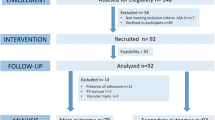Abstract
Laparoscopic surgery with CO2 insufflation is associated with adverse effects on hemodynamics and gas exchange. The abdominal wall retractor (AWR) is an alternative for pneumoperitoneum. Hemodynamics and gas exchange during the use of an AWR were compared to those of CO2 pneumoperitoneum.
In eight pigs subjected to 1 h of CO2 pneumoperitoneum or abdominal wall retraction, hemodynamics, gas exchange, and oxygen transport were studied in a randomized cross-over study design.
The only change observed during abdominal wall retraction was mild respiratory alkalosis. In contrast, during CO2 pneumoperitoneum mean arterial blood pressure increased 13%, central filling pressures doubled, and a small increase in cardiac output was observed. Peak airway pressures increased 50%, end-tidal CO2 increased 20%, and respiratory acidosis was induced (arterial pH from 7.46±0.07 to 7.31±0.06 and pCO2 from 33±3 mmHg to 53±4 mmHg). Arterial PO2 decreased but mixed venous oxygen saturation and oxygen consumption were unaffected.
In contrast with CO2 pneumoperitoneum, laparoscopy using abdominal wall retraction was not associated with adverse effects on hemodynamics or gas exchange.
Similar content being viewed by others
References
Araki K, Namikawa K, Yamamoto H, Mizutani J, Doiguchi M, Arai M, Yamaguchi T, Uno K, Ido Y, Hayashi N (1993) Abdominal wall retraction during laparoscopic cholecystectomy. World J Surg 17: 105–107
Banting S, Shimi S, Vander VG, Cuschieri A (1993) Abdominal wall lift. Low-pressure pneumoperitoneum laparoscopic surgery. Surg Endosc 7: 57–59
Bongard FS, Pianim NA, Leighton TA, Dubecz S, Davis IP, Lippmann M, Klein S, Liu SY (1993) Helium insufflation for laparoscopic operation. Surg Gynecol Obstet 177: 140–146
Cunningham AJ, Schlanger M (1992) Intraoperative hypoxemia complicating laparoscopic cholecystectomy in a patient with sickle hemoglobinopathy. Anesth Analg 75: 838–843
Fitzgerald SD, Andrus CH, Baudendistel LJ, Dahms TE, Kaminski DL (1992) Hypercarbia during carbon dioxide pneumoperitoneum. Am J Surg 163: 186–190
Hall D, Goldstein A, Tynan E, Braunstein L (1993) Profound hypercarbia late in the course of laparoscopic cholecystectomy: detection by continuous capnometry. Anesthesiology 79: 173–174
Harris MNE, Plantevin OM, Crowther A (1984) Cardiac arrhythmias during anaesthesia for laparoscopy. Br J Anaesth 56: 1213–1217
Hashimoto D, Nayeem SA, Kajiwara S, Hoshino T (1993) Laparoscopic cholecystectomy: an approach without pneumoperitoneum. Surg Endosc 7: 54–56
Hills M, Armitage P (1979) The two-period cross-over clinical trial. Br J Clin Pharmacol 8: 7–20
Ho HS, Saunders CJ, Corso FA, Wolfe BM (1993) The effects of CO2 pneumoperitoneum on hemodynamics in hemorrhaged animals. Surgery 114: 381–387
Joris JL, Noirot DP, Legrand MJ, Jacquet NJ, Lamy ML (1993) Hemodynamic changes during laparoscopic cholecystectomy. Anesth Analg 76: 1067–1071
Kitano S, Tomikawa M, Iso Y, Iwata S, Gondo K, Moriyama M, Sugimachi K (1992) A safe and simple method to maintain a clear field of vision during laparoscopic cholecystectomy. Surg Endosc 6: 197–198
Kotzampassi K, Kapanidis N, Kazamias P, Eleftheriadis E (1993) Hemodynamic events in the peritoneal environment during pneumoperitoneum in dogs. Surg Endosc 7: 494–499
Leighton T, Pianim N, Liu S, Kono M, Klein S, Bongard F (1992) Effectors of hypercarbia during experimental pneumoperitoneum. Am Surg 58: 717–721
Leighton TA, Liu S, Bongard FS (1993) Comparative cardiopulmonary effects of carbon dioxide versus helium pneumoperitoneum. Surgery 113: 527–531
Lister DV, Rudston-Brown B, Wrriner B, McEwen J, Chan M, Walley K (1994) Carbon dioxide absorption is not linearly related to intraperitoneal carbon dioxide insufflation pressure in pigs. Anesthesiology 80: 129–136
Nelson LD (1987) Mixed venous oximetry. In: Snyder JV, Pinsky MR (eds) Oxygen transport in the critically ill. Yearbook, Chicago, pp 235–248
Neuman GG, Sidebotham G, Negoianu E, Bernstein J, Kopman AF, Hicks RG, West ST, Haring L (1993) Laparoscopy explosion hazards with nitrous oxide. Anesthesiology 78: 875–879
Rasmussen JP, Dauchot PJ, DePalma RG, Sorensen B, Regula G, Anton A, Gravenstein JS (1978) Cardiac function and hypercarbia. Arch Surg 113: 1196–1200
Rosser TC (1993) Pediatric Laparoscopy. In: Zucker KA (ed) Surgical laparoscopy update. Quality Medical Publishing, St Louis
Scott DB, Julian DG (1972) Observations on cardiac arrhythmias during laparoscopy. Br Med J 3: 410–412
Sha M, Ohmura A, Yamada M (1991) Diaphragm function and pulmonary complications after laparoscopic cholecystectomy. Anesthesiology 75 (Suppl): A255
Slutsky AS (1993) Mechanical ventilation. Chest 104: 1833–1859
Van Den Bos GC, Drake AJ, Noble MI (1979) The effect of carbon dioxide upon myocardial contractile performance, blood flow, and oxygen consumption. J Physiol 287: 149–161
Versprille A, Jansen JRC, Frietman RC, Hulsman AR (1990) Negative effect of insufflation on cardiac output and pulmonary blood volume. Acta Anaesthesiol Scand 34: 607–615
Wahba RW, Mamazza J (1993) Ventilatory requirements during laparoscopic cholecystectomy. Can J Anaesth 40: 206–210
Williams MD, Murr PC (1993) Laparoscopic insufflation of the abdomen depresses cardiopulmonary function. Surg Endosc 7: 12–16
Wittgen CM, Andrus CH, Fitzgerald SD, Baudendistel LJ, Dahms TE, Kaminski DL (1991) Analysis of the hemodynamic ventilatory effects of laparoscopic cholecystectomy. Arch Surg 126: 997–1000
Author information
Authors and Affiliations
Rights and permissions
About this article
Cite this article
Rademaker, B.M.P., Meyer, D.W., Bannenberg, J.J.G. et al. Laparoscopy without pneumoperitoneum. Surg Endosc 9, 797–801 (1995). https://doi.org/10.1007/BF00190084
Accepted:
Issue Date:
DOI: https://doi.org/10.1007/BF00190084




